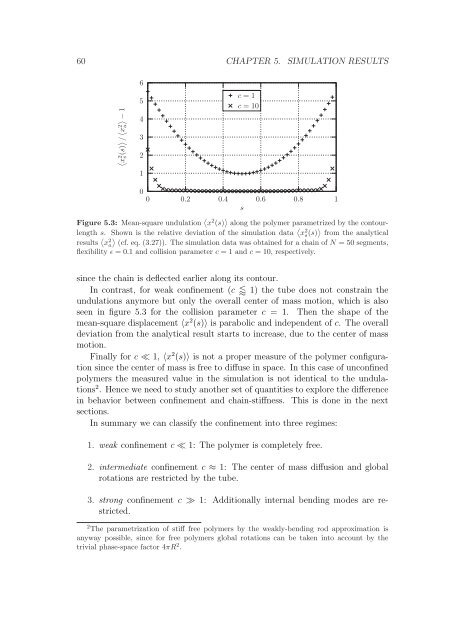Polymers in Confined Geometry.pdf
Polymers in Confined Geometry.pdf
Polymers in Confined Geometry.pdf
You also want an ePaper? Increase the reach of your titles
YUMPU automatically turns print PDFs into web optimized ePapers that Google loves.
60 CHAPTER 5. SIMULATION RESULTS<br />
− 1<br />
x 2 s (s) / x 2 a<br />
6<br />
5<br />
4<br />
3<br />
2<br />
1<br />
0<br />
0<br />
0.2<br />
0.4<br />
c = 1<br />
c = 10<br />
Figure 5.3: Mean-square undulation x2 (s) along the polymer parametrized by the contourlength<br />
s. Shown is the relative deviation of the simulation data x2 s(s) from the analytical<br />
results x2 <br />
a (cf. eq. (3.27)). The simulation data was obta<strong>in</strong>ed for a cha<strong>in</strong> of N = 50 segments,<br />
flexibility ɛ = 0.1 and collision parameter c = 1 and c = 10, respectively.<br />
s<strong>in</strong>ce the cha<strong>in</strong> is deflected earlier along its contour.<br />
In contrast, for weak conf<strong>in</strong>ement (c 1) the tube does not constra<strong>in</strong> the<br />
undulations anymore but only the overall center of mass motion, which is also<br />
seen <strong>in</strong> figure 5.3 for the collision parameter c = 1. Then the shape of the<br />
mean-square displacement 〈x 2 (s)〉 is parabolic and <strong>in</strong>dependent of c. The overall<br />
deviation from the analytical result starts to <strong>in</strong>crease, due to the center of mass<br />
motion.<br />
F<strong>in</strong>ally for c ≪ 1, 〈x 2 (s)〉 is not a proper measure of the polymer configuration<br />
s<strong>in</strong>ce the center of mass is free to diffuse <strong>in</strong> space. In this case of unconf<strong>in</strong>ed<br />
polymers the measured value <strong>in</strong> the simulation is not identical to the undulations<br />
2 . Hence we need to study another set of quantities to explore the difference<br />
<strong>in</strong> behavior between conf<strong>in</strong>ement and cha<strong>in</strong>-stiffness. This is done <strong>in</strong> the next<br />
sections.<br />
In summary we can classify the conf<strong>in</strong>ement <strong>in</strong>to three regimes:<br />
1. weak conf<strong>in</strong>ement c ≪ 1: The polymer is completely free.<br />
2. <strong>in</strong>termediate conf<strong>in</strong>ement c ≈ 1: The center of mass diffusion and global<br />
rotations are restricted by the tube.<br />
3. strong conf<strong>in</strong>ement c ≫ 1: Additionally <strong>in</strong>ternal bend<strong>in</strong>g modes are restricted.<br />
2 The parametrization of stiff free polymers by the weakly-bend<strong>in</strong>g rod approximation is<br />
anyway possible, s<strong>in</strong>ce for free polymers global rotations can be taken <strong>in</strong>to account by the<br />
trivial phase-space factor 4πR 2 .<br />
s<br />
0.6<br />
0.8<br />
1













